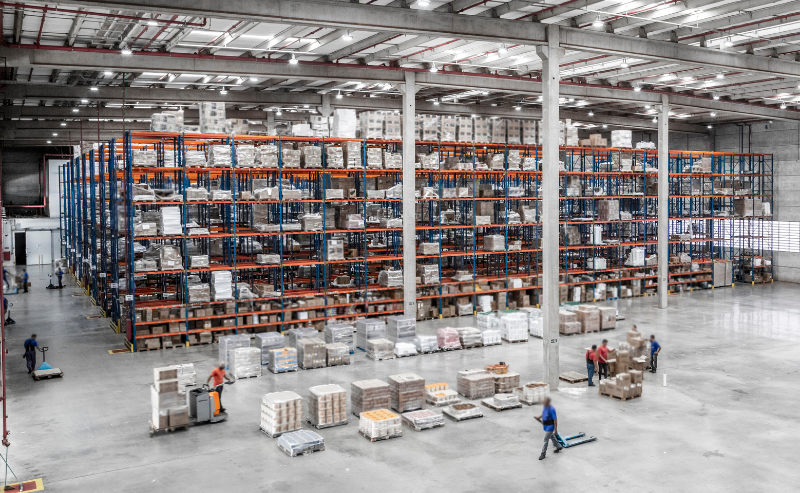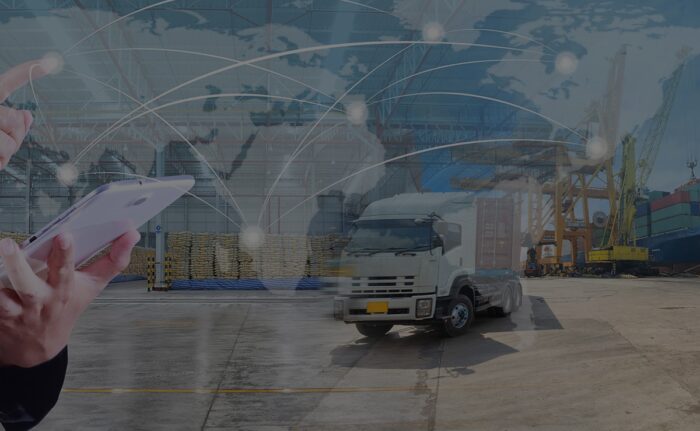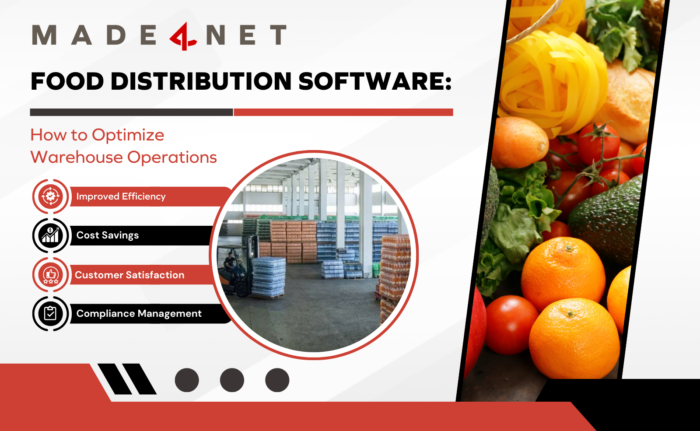
Finding the right food distribution software for your operation takes a deep understanding of your business requirements and growth goals. Food distribution requires accurate temperature tracking, compliance documentation, and sophisticated tracking. While many companies opt to use a food and beverage Warehouse Management System (WMS), others make use of their Enterprise Resource Planning (ERP) system. So, how do you choose the right system for your business?
This article will help with that decision. In this article, we’ll discuss:
- What is a WMS Used For in Food Distribution?
- What is an ERP Used For in Food Distribution?
- ERP vs. WMS: What are the Key Differences Between the Two Food & Beverage Distribution Software Options?
- When Should I Choose a Food & Beverage WMS?
- Common Challenges to Avoid When Choosing Food Distribution Software
What is a WMS Used For in Food Distribution?
In food distribution, a WMS acts as the operational heart of the warehouse, managing everything from receipt and put‑away to picking, packing, and shipping. It enables real-time inventory tracking, zone-specific workflows, and temperature-sensitive lot and expiration control, ensuring freshness and safety. Modern WMS platforms are designed for industries like food and beverage, offering tight integration with automation and compliance systems to reduce spoilage and streamline the supply chain.
What is an ERP Used For in Food Distribution?
Enterprise Resource Planning (ERP) systems are broad, organizational-level platforms that integrate core business functions, such as finance, procurement, sales order processing, and basic inventory tracking. Organizations use ERPs to manage and integrate the essential parts of their business operations. An ERP allows for better visibility, coordination, and efficiency across an organization. It helps ensure that different departments can easily share information, leading to improved decision-making, reduced costs, and enhanced productivity.
In the context of food distribution, ERPs are typically used to manage purchasing, billing, and financial reporting as their warehouse modules are typically basic and lack the advanced operational optimization and real-time execution features that a WMS provides.
ERP vs. WMS: What are the Key Differences Between the Two Food & Beverage Distribution Software Options?
While both an ERP and WMS are critical for the efficient functioning of the supply chain, they are not created equally, especially in terms of food and beverage distribution. While one provides broad functionality, the other narrows its focus to bring efficiency to specific operations.
| Aspect | ERP | WMS |
|---|---|---|
| Scope | Broad: enterprise-wide system covering finance, HR, procurement, sales, and more | Focused: purpose-built for warehouse operations, inventory, and fulfillment |
| Inventory Management | High-level accounting view; primarily focused on valuation and financial reporting, with limited visibility into stock location or movement | Proactive, real-time granular tracking down to bins, lots, serial numbers, and expiration dates |
| Warehouse Optimization | Limited. ERP systems support only basic or static warehouse functions (e.g., RF data capture or a single location reference). Their primary role is financial—managing the balance sheet and reporting profit/loss—so operational optimization is minimal. | Advanced optimization features such as task interleaving, pick-path optimization, cartonization, wave and zone logic. WMS drives efficiency, accuracy, and utilization of labor and equipment, with systemic control of inventory rotation. |
| Execution Control | Largely passive. Provides manual instructions and relies on users for execution, with limited operational control. | Active execution engine. Directs warehouse tasks in real time, supports automation (conveyors, robotics), voice-directed picking, and dynamic adjustments based on current conditions. |
| Integration Role | Central business hub connecting enterprise functions. Without a WMS, the ERP must manage warehouse tasks directly—an inefficient approach that strains resources. | Works alongside ERP for operational excellence. The ERP typically acts as the Order Management System (OMS), passing inbound and outbound orders to the WMS. The WMS then executes those orders, systemically driving warehouse operations with a focus on accuracy and efficiency. |
These five categories are a great way to gain a basic understanding of what you can achieve with either solution. Discerning whether you need an ERP or a Food and Beverage WMS will depend on your operational goals and needs.
When Should I Choose a Food & Beverage WMS?
If your food and beverage operations go beyond basic inventory tracking and order fulfillment, it’s time to consider a dedicated WMS. ERP systems may offer broad functionality, but they often lack the precision and depth required for high-volume, high-velocity, perishable environments.
Choose a food and beverage WMS when:
- You manage expiration dates, batch/lot tracking, or cold-chain requirements.
- You operate in multi-temperature zones or across multiple facilities.
- You need real-time picking, packing, and fulfillment capabilities.
- You rely on automation, conveyors, or temperature-monitoring sensors.
- You must comply with strict food safety and traceability regulations.
- Your customer requirements demand speed, accuracy, and visibility.
As your business scales, so do the risks of inefficiency, waste, and non-compliance. A food and beverage WMS gives you the control, automation, and agility to stay ahead—something ERP alone simply can’t deliver.
Common Challenges to Avoid When Choosing Food Distribution Software
Choosing enterprise software is no easy feat. If you’ve already invested in an ERP, it may be tempting to assume it can function as a complete food and beverage solution—but that’s rarely the case. When evaluating options, avoid these five common pitfalls:
- Assuming ERP WMS Modules Are Enough
Most ERP systems offer basic warehouse functionality—but they typically lack advanced capabilities like batch picking, temperature-zone management, real-time automation control, and built-in compliance tools. These are essential in food and beverage distribution, where precision and speed are non-negotiable. - Neglecting ERP Integration
Your WMS must seamlessly integrate with your ERP. Without this, you risk inventory mismatches, fulfillment delays, and compliance gaps. A well-integrated ERP–WMS ecosystem enables consistent data flow across finance, procurement, manufacturing, and warehouse operations. - Overlooking Industry-Specific Requirements
Food and beverage distribution isn’t generic. You need functionality like lot and batch tracking, expiration management, cold-chain visibility, allergen segregation, and compliance reporting. Generic WMS or ERP tools often miss these critical capabilities. - Ignoring Scalability and Automation Readiness
As order volumes rise and operations grow more complex, manual processes break down. Look for solutions that support voice picking, directed putaway, dynamic slotting, and real-time adjustments in multi-temperature environments. - Failing to Align Software with Performance Goals
Don’t just check feature boxes—validate performance. Evaluate systems based on real metrics like pick rate, inventory accuracy, shrink reduction, throughput, and traceability speed. Your software should meet your operational KPIs, not just look good in a demo.
Do you need a Food and Beverage WMS?
Food distribution comes with unique challenges, requiring full visibility, streamlined automation, and strict compliance controls. From precise inventory tracking to optimized transportation and seamless integrations, the right tools make all the difference. Purpose-built software, like a food and beverage WMS, empowers food distributors to cut waste, boost efficiency, and stay ahead of evolving regulatory demands.
Looking to strengthen your food supply chain? Discover how Made4net’s Food & Beverage WMS can drive accuracy, productivity, and peace of mind. Talk to one of our experts today.


